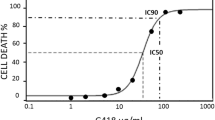Abstract
The α-subunit of C-phycocyanin (CpcA) was expressed in Escherichia coli and purified. The recombinant CpcA inhibited the growth of human colon carcinoma COLO 205 cells. Typical apoptotic morphological characteristics, such as chromatin condensation and nuclear fragmentation, were observed in CpcA-treated COLO 205 cells by fluorescence microscopy and transmission electron microscopy. Moreover, the apoptotic process was associated with the Bax/Bcl-2 ratio up-regulation, mitochondrial membrane depolarization, cytochrome c release, and caspase-9 activation. These findings indicate that CpcA induced the death of COLO 205 cells through the intrinsic apoptotic pathway.





Similar content being viewed by others
References
Brard L, Granai CO, Swamy N (2006) Iron chelators deferoxamine and diethylenetriamine pentaacetic acid induce apoptosis in ovarian carcinoma. Gynecol Oncol 100:116–127
Carlson K, Jortner BS, Ehrich M (2000) Organophosphorus compound-induced apoptosis in SH-SY5Y human neuroblastoma cells. Toxicol Appl Pharmacol 168:102–113
Chiu B, Mirkin B, Madonna MB (2007) Epidermal growth factor can induce apoptosis in neuroblastoma. J Pediatr Surg 42:482–488
Eriksen NT (2008) Production of phycocyanin—a pigment with applications in biology, biotechnology, foods and medicine. Appl Microbiol Biotechnol 80:1–14
Giansanti V, Camboni T, Piscitelli F et al (2009) Study of the effects of a new pyrazolecarboxamide: changes in mitochondria and induction of apoptosis. Int J Biochem Cell Biol 41:1890–1898
Ito C, Itoigawa M, Nakao K et al (2006) Induction of apoptosis by carbazole alkaloids isolated from Murraya koenigii. Phytomedicine 13:359–365
Lou H, Kaur K, Sharma AK et al (2006) Adriamycin-induced oxidative stress, activation of MAP kinases and apoptosis in isolated cardiomyocytes. Pathophysiology 13:103–109
Mccarty MF (2007) Clinical potential of Spirulina as a source of phycocyanobilin. J Med Food 10:566–570
Meeran SM, Katiyar S, Katiyar SK (2008) Berberine-induced apoptosis in human prostate cancer cells is initiated by reactive oxygen species generation. Toxicol Appl Pharmacol 229:33–43
Pardhasaradhi BV, Ali AM, Kumari AL et al (2003) Phycocyanin-mediated apoptosis in AK-5 tumor cells involves down-regulation of Bcl-2 and generation of ROS. Mol Cancer Ther 2:1165–1170
Patel A, Mishra S, Ghosh PK (2006) Antioxidant potential of C-phycocyanin isolated from cyanobacterial species Lyngbya, Phormidium and Spirulina spp. Indian J Biochem Biophys 43:25–31
Patil G, Chethana S, Madhusudhan MC et al (2008) Fractionation and purification of the phycobiliproteins from Spirulina platensis. Bioresour Technol 99:7393–7396
Romay C, Armesto J, Remirez D et al (1998) Antioxidant and anti-inflammatory properties of C-phycocyanin from blue-green algae. Inflamm Res 47:36–41
Roy KR, Arunasree KM, Reddy NP et al (2007) Alteration of mitochondrial membrane potential by Spirulina platensis C-phycocyanin induces apoptosis in the doxorubicinresistant human hepatocellular-carcinoma cell line HepG2. Biotechnol Appl Biochem 47:159–167
Subhashini J, Mahipal SV, Reddy MC et al (2004) Molecular mechanisms in C-phycocyanin induced apoptosis in human chronic myeloid leukemia cell line-K562. Biochem Pharmacol 68:453–462
Wang H, Liu Y, Gao X et al (2007) The recombinant β subunit of C-phycocyanin inhibits cell proliferation and induces apoptosis. Cancer Lett 247:150–158
Acknowledgements
This work was supported by grants from the Doctoral Education Fund of Ministry of Education of China (20070353002), the Nature Science Foundation of Zhejiang Province of China (Y4080060), and the Youth Talent Program of Zhejiang Gongshang University of China (Q07–09).
Author information
Authors and Affiliations
Corresponding authors
Rights and permissions
About this article
Cite this article
Lu, W., Yu, P. & Li, J. Induction of apoptosis in human colon carcinoma COLO 205 cells by the recombinant α subunit of C-phycocyanin. Biotechnol Lett 33, 637–644 (2011). https://doi.org/10.1007/s10529-010-0464-9
Received:
Accepted:
Published:
Issue Date:
DOI: https://doi.org/10.1007/s10529-010-0464-9




